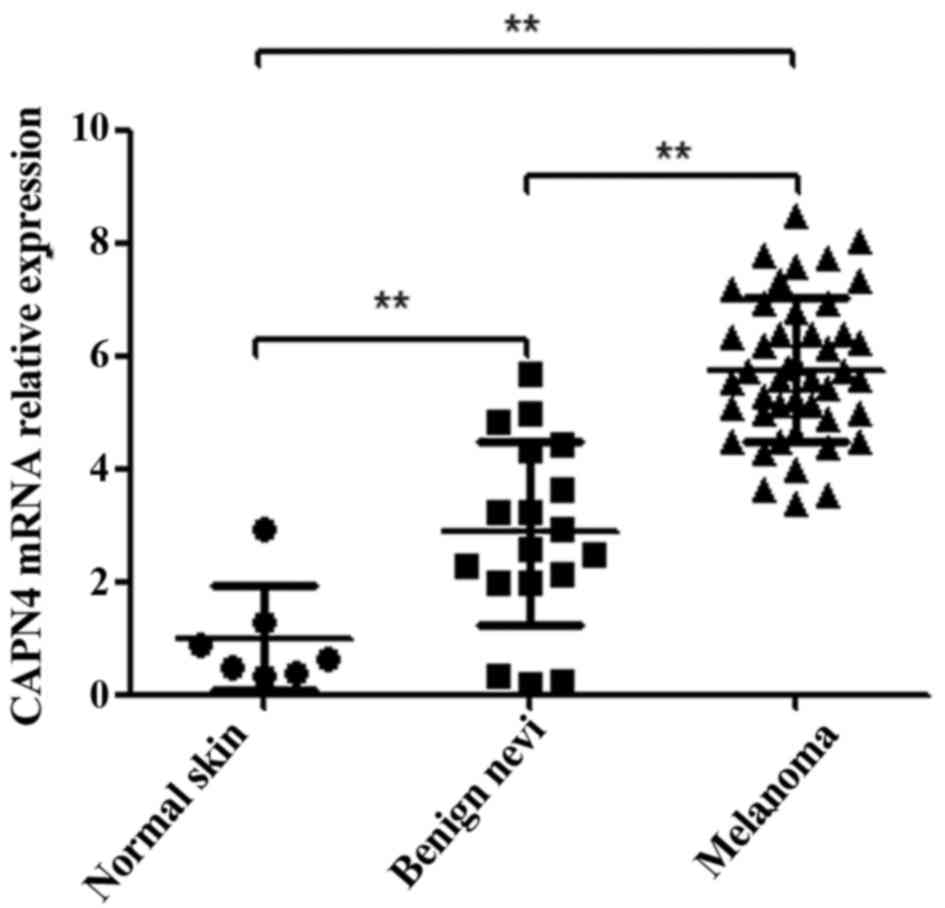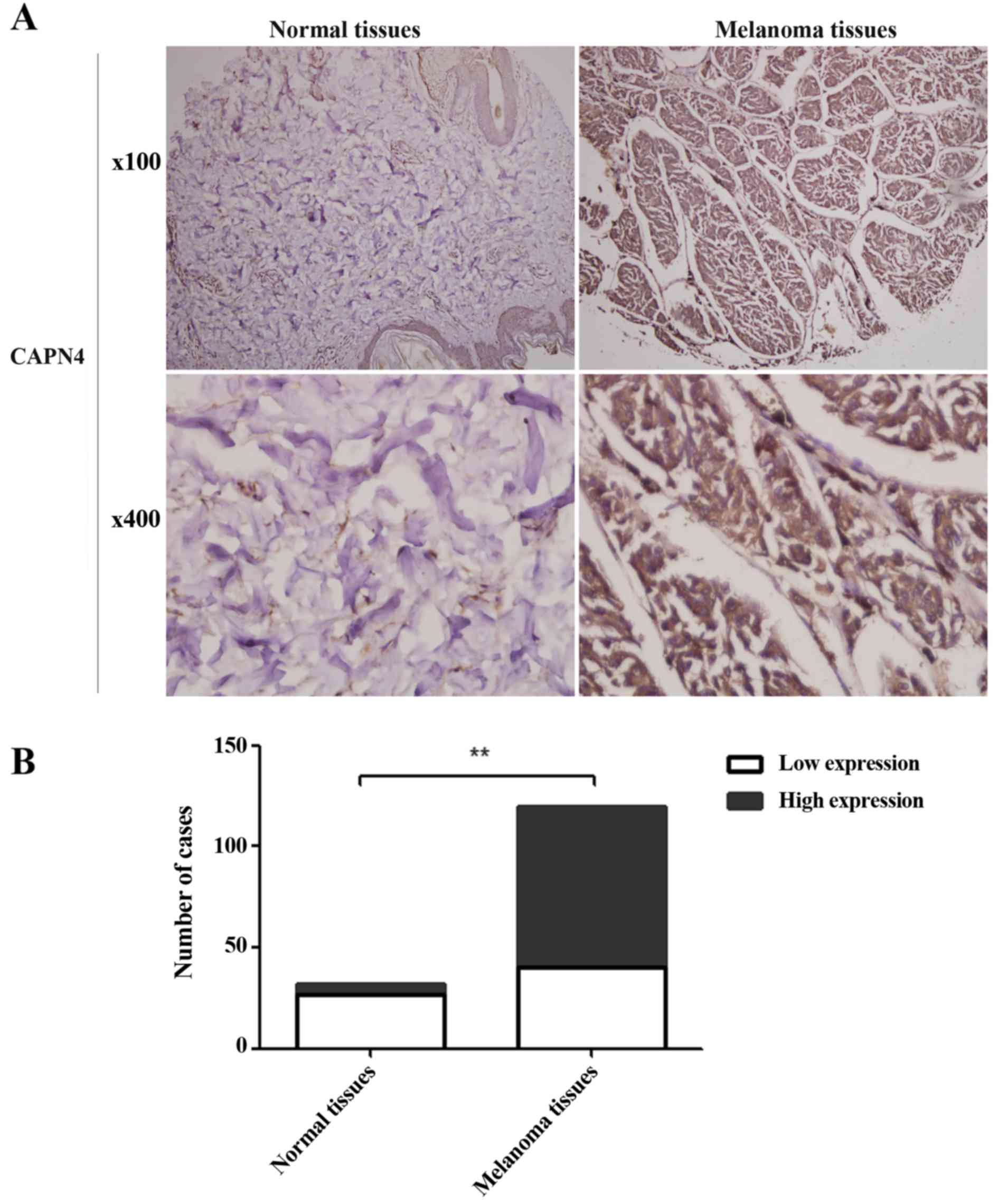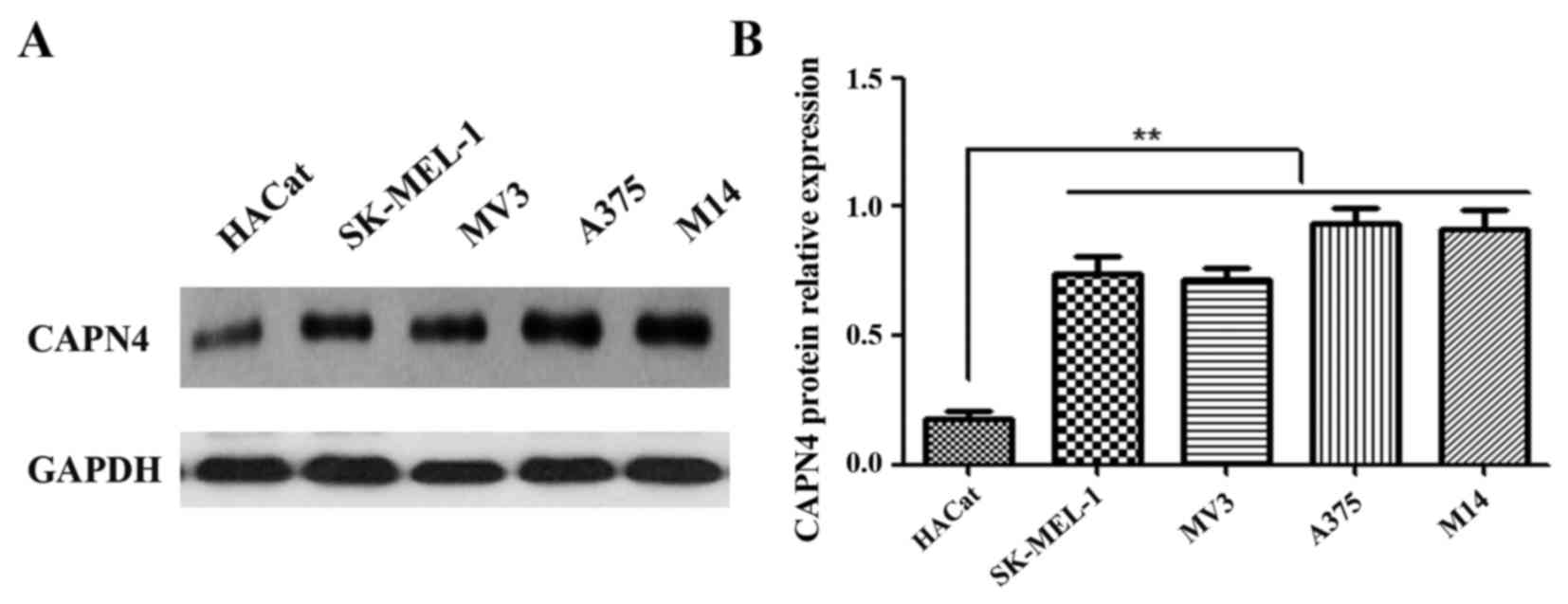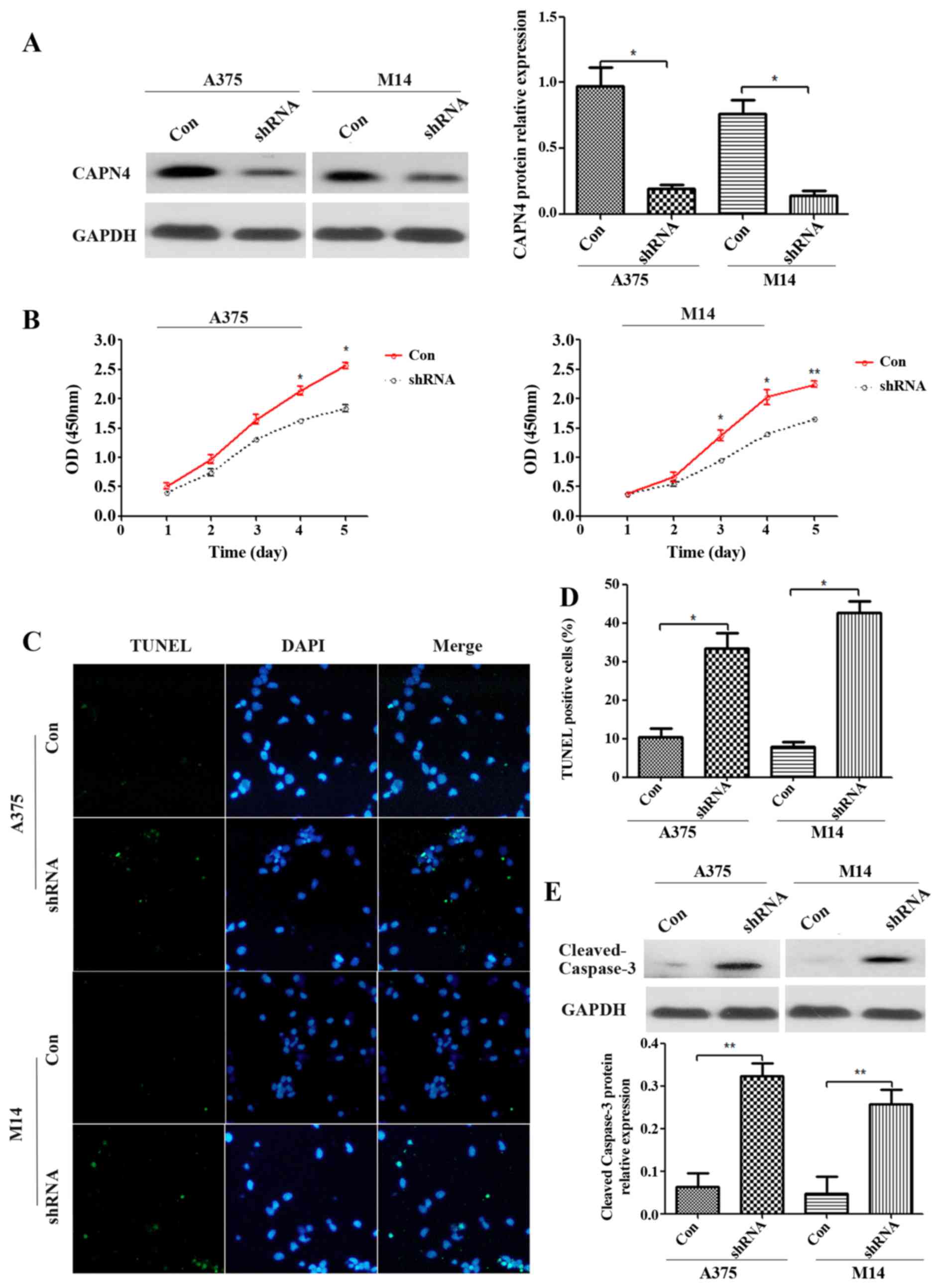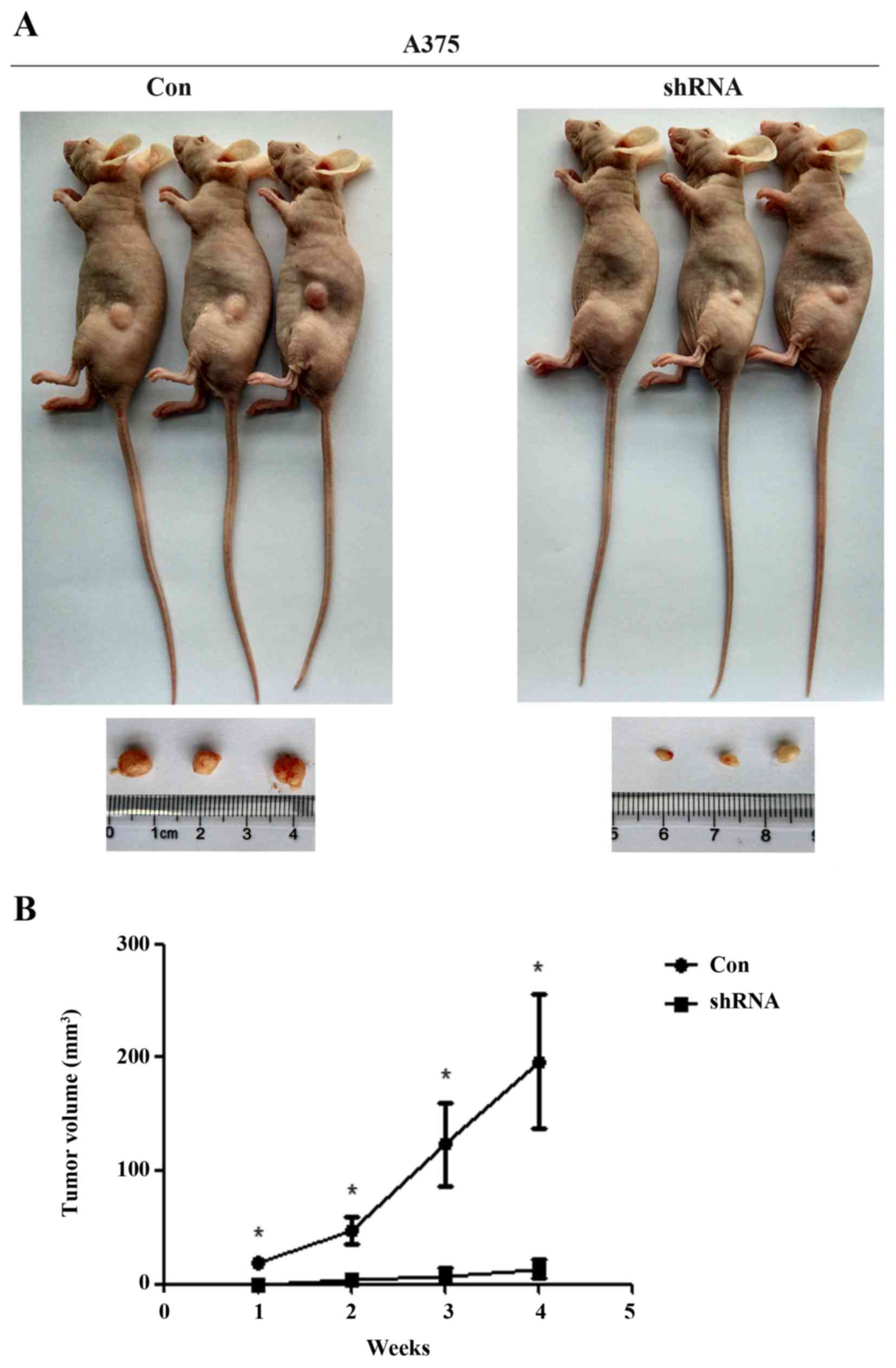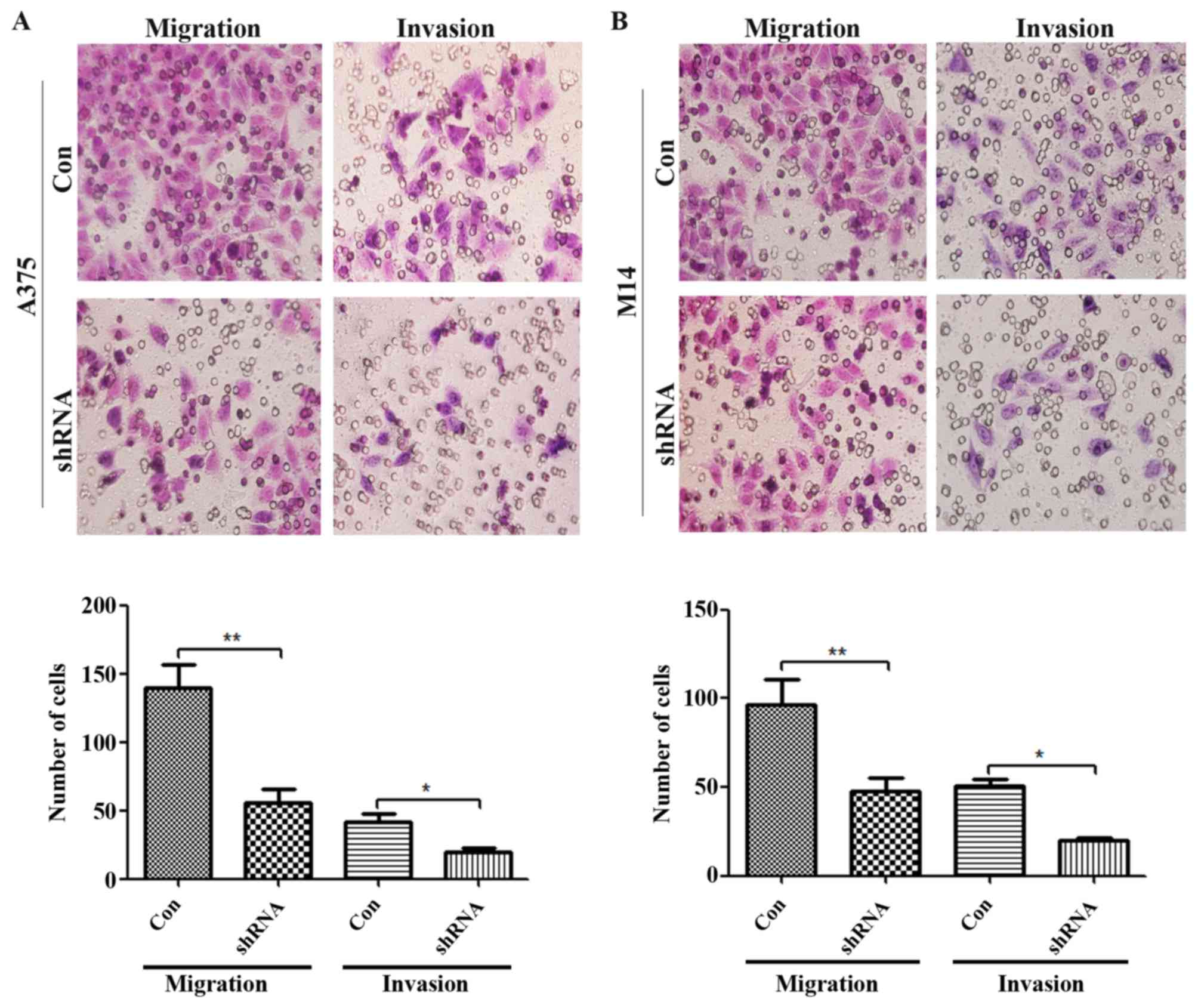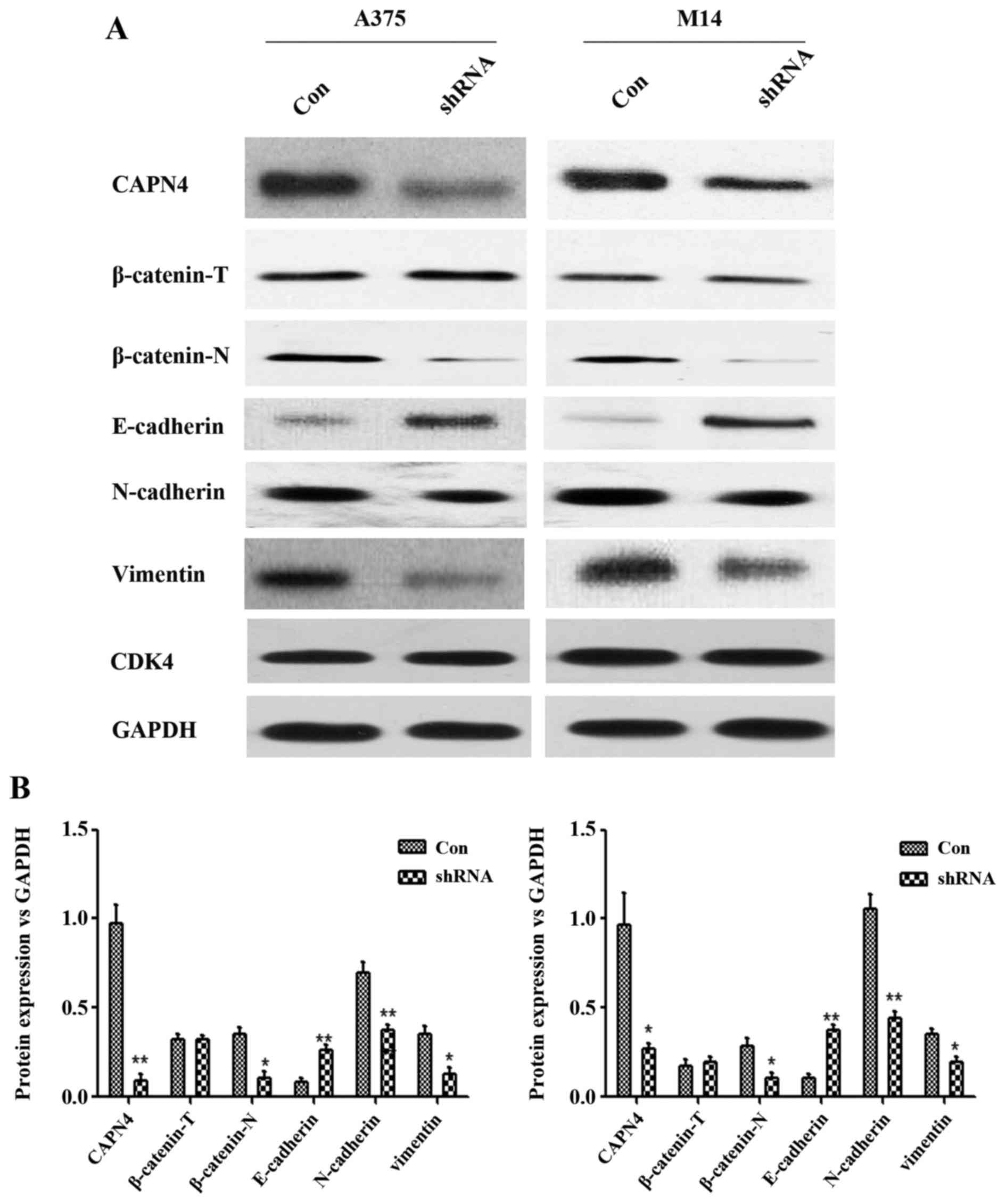|
1
|
Petrella T, Verma S, Spithoff K, Quirt I
and McCready D: Melanoma disease site group: Adjuvant interferon
therapy for patients at high risk for recurrent melanoma: An
updated systematic review and practice guideline. Clin Oncol (R
Coll Radiol). 24:413–423. 2012. View Article : Google Scholar : PubMed/NCBI
|
|
2
|
Siegel R, Naishadham D and Jemal A: Cancer
statistics, 2013. CA Cancer J Clin. 63:11–30. 2013. View Article : Google Scholar : PubMed/NCBI
|
|
3
|
Lin K, Baritaki S, Militello L, Malaponte
G, Bevelacqua Y and Bonavida B: The role of B-RAF mutations in
melanoma and the induction of EMT via dysregulation of the
NF-κB/Snail/RKIP/PTEN circuit. Genes Cancer. 1:409–420. 2010.
View Article : Google Scholar : PubMed/NCBI
|
|
4
|
Zheng H, Gao L, Feng Y, Yuan L, Zhao H and
Cornelius LA: Down-regulation of Rap1GAP via promoter
hypermethylation promotes melanoma cell proliferation, survival,
and migration. Cancer Res. 69:449–457. 2009. View Article : Google Scholar : PubMed/NCBI
|
|
5
|
Larkin JM, Fisher RA and Gore ME: Adjuvant
interferon therapy for patients at high risk for recurrent
melanoma: An updated systematic review. Clin Oncol (R Coll Radiol).
24:410–412. 2012. View Article : Google Scholar : PubMed/NCBI
|
|
6
|
Lu S and Guo J: Interpretation of clinical
practice guidelines for management of melanoma in China (new
version of 2011). Chin Clin Oncol. 2:159–171. 2012.
|
|
7
|
Yang AS and Chapman PB: The history and
future of chemotherapy for melanoma. Hematol Oncol Clin North Am.
23:583–597. 2009. View Article : Google Scholar : PubMed/NCBI
|
|
8
|
Smith BN and Bhowmick NA: Role of EMT in
metastasis and therapy resistance. J Clin Med. 5:172016. View Article : Google Scholar
|
|
9
|
Tsui KH, Lin YH, Chung LC, Chuang ST, Feng
TH, Chiang KC, Chang PL, Yeh CJ and Juang HH: Prostate-derived ets
factor represses tumorigenesis and modulates
epithelial-to-mesenchymal transition in bladder carcinoma cells.
Cancer Lett. 375:142–151. 2016. View Article : Google Scholar : PubMed/NCBI
|
|
10
|
Cong J, Goll DE, Peterson AM and Kapprell
HP: The role of autolysis in activity of the
Ca2+-dependent proteinases (µ-calpain and m-calpain). J
Biol Chem. 264:10096–10103. 1989.PubMed/NCBI
|
|
11
|
Goll DE, Thompson VF, Li H, Wei W and Cong
J: The calpain system. Physiol Rev. 83:731–801. 2003. View Article : Google Scholar : PubMed/NCBI
|
|
12
|
Storr SJ, Carragher NO, Frame MC, Parr T
and Martin SG: The calpain system and cancer. Nat Rev Cancer.
11:364–374. 2011. View
Article : Google Scholar : PubMed/NCBI
|
|
13
|
Fan DG, Dai JY, Tang J, Wu MM, Sun SG,
Jiang JL and Fan QY: Silencing of calpain expression reduces the
metastatic potential of human osteosarcoma cells. Cell Biol Int.
33:1263–1267. 2009. View Article : Google Scholar : PubMed/NCBI
|
|
14
|
Roumes H, Leloup L, Dargelos E, Brustis
JJ, Daury L and Cottin P: Calpains: Markers of tumor
aggressiveness? Exp Cell Res. 316:1587–1599. 2010. View Article : Google Scholar : PubMed/NCBI
|
|
15
|
Chen B, Tang J, Guo YS, Li Y, Chen ZN and
Jiang JL: Calpains are required for invasive and metastatic
potentials of human HCC cells. Cell Biol Int. 37:643–652. 2013.
View Article : Google Scholar : PubMed/NCBI
|
|
16
|
Zhang X, You X, Wang Q, Zhang T, Du Y, Lv
N, Zhang Z, Zhang S, Shan C, Ye L, et al: Hepatitis B virus X
protein drives multiple cross-talk cascade loops involving NF-κB,
5-LOX, OPN and Capn4 to promote cell migration. PLoS One.
7:e314582012. View Article : Google Scholar : PubMed/NCBI
|
|
17
|
Lakshmikuttyamma A, Selvakumar P, Kanthan
R, Kanthan SC and Sharma RK: Overexpression of m-calpain in human
colorectal adenocarcinomas. Cancer Epidemiol Biomarkers Prev.
13:1604–1609. 2004.PubMed/NCBI
|
|
18
|
Shiba E, Kambayashi JI, Sakon M, Kawasaki
T, Kobayashi T, Koyama H, Yayoi E, Takatsuka Y and Takai SI:
Ca2+-dependent neutral protease (calpain) activity in
breast cancer tissue and estrogen receptor status. Breast Cancer.
3:13–17. 1996. View Article : Google Scholar : PubMed/NCBI
|
|
19
|
Pamonsinlapatham P, Gril B, Dufour S,
Hadj-Slimane R, Gigoux V, Pethe S, Lhoste S, Camonis J, Garbay C,
Raynaud F, et al: Capns1, a new binding partner of RasGAP-SH3
domain in K-RasV12 oncogenic cells: Modulation of cell
survival and migration. Cell Signal. 20:2119–2126. 2008. View Article : Google Scholar : PubMed/NCBI
|
|
20
|
Cai JJ, Qi ZX, Chen LC, Yao Y, Gong Y and
Mao Y: miR-124 suppresses the migration and invasion of glioma
cells in vitro via Capn4. Oncol Rep. 35:284–290. 2016.PubMed/NCBI
|
|
21
|
Zhang C, Bai DS, Huang XY, Shi GM, Ke AW,
Yang LX, Yang XR, Zhou J and Fan J: Prognostic significance of
Capn4 overexpression in intrahepatic cholangiocarcinoma. PLoS One.
8:e546192013. View Article : Google Scholar : PubMed/NCBI
|
|
22
|
Zhuang Q, Qian X, Cao Y, Fan M, Xu X and
He X: Capn4 mRNA level is correlated with tumour progression and
clinical outcome in clear cell renal cell carcinoma. J Int Med Res.
42:282–291. 2014. View Article : Google Scholar : PubMed/NCBI
|
|
23
|
Zheng PC, Chen X, Zhu HW, Zheng W, Mao LH,
Lin C, Liu JN and Zheng M: Capn4 is a marker of poor clinical
outcomes and promotes nasopharyngeal carcinoma metastasis via
nuclear factor-κB-induced matrix metalloproteinase 2 expression.
Cancer Sci. 105:630–638. 2014. View Article : Google Scholar : PubMed/NCBI
|
|
24
|
Gu J, Xu FK, Zhao GY, Lu CL, Lin ZW, Ding
JY and Ge D: Capn4 promotes non-small cell lung cancer progression
via upregulation of matrix metalloproteinase 2. Med Oncol.
32:512015. View Article : Google Scholar : PubMed/NCBI
|
|
25
|
Talantov D, Mazumder A, Yu JX, Briggs T,
Jiang Y, Backus J, Atkins D and Wang Y: Novel genes associated with
malignant melanoma but not benign melanocytic lesions. Clin Cancer
Res. 11:7234–7242. 2005. View Article : Google Scholar : PubMed/NCBI
|
|
26
|
Chin L, Garraway LA and Fisher DE:
Malignant melanoma: Genetics and therapeutics in the genomic era.
Genes Dev. 20:2149–2182. 2006. View Article : Google Scholar : PubMed/NCBI
|
|
27
|
Uchibori R, Tsukahara T, Mizuguchi H, Saga
Y, Urabe M, Mizukami H, Kume A and Ozawa K: NF-κB activity
regulates mesenchymal stem cell accumulation at tumor sites. Cancer
Res. 73:364–372. 2013. View Article : Google Scholar : PubMed/NCBI
|
|
28
|
Tarapore RS, Siddiqui IA, Saleem M, Adhami
VM, Spiegelman VS and Mukhtar H: Specific targeting of
Wnt/β-catenin signaling in human melanoma cells by a dietary
triterpene lupeol. Carcinogenesis. 31:1844–1853. 2010. View Article : Google Scholar : PubMed/NCBI
|
|
29
|
Yuan G, Zhang B, Yang S, Jin L, Datta A,
Bae S, Chen X and Datta PK: Novel role of STRAP in progression and
metastasis of colorectal cancer through Wnt/β-catenin signaling.
Oncotarget. 7:16023–16037. 2016.PubMed/NCBI
|
|
30
|
Lucero OM, Dawson DW, Moon RT and Chien
AJ: A re-evaluation of the ‘oncogenic’ nature of Wnt/β-catenin
signaling in melanoma and other cancers. Curr Oncol Rep.
12:314–318. 2010. View Article : Google Scholar : PubMed/NCBI
|
|
31
|
Hu S, Luo Q, Cun B, Hu D, Ge S, Fan X and
Chen F: The pharmacological NF-κB inhibitor BAY11-7082 induces cell
apoptosis and inhibits the migration of human uveal melanoma cells.
Int J Mol Sci. 13:15653–15667. 2012. View Article : Google Scholar : PubMed/NCBI
|
|
32
|
Shan X, Tian LL, Zhang YM, Wang XQ, Yan Q
and Liu JW: Ginsenoside Rg3 suppresses FUT4 expression through
inhibiting NF-κB/p65 signaling pathway to promote melanoma cell
death. Int J Oncol. 47:701–709. 2015.PubMed/NCBI
|
|
33
|
Du Q, Zhang X, Cardinal J, Cao Z, Guo Z,
Shao L and Geller DA: Wnt/β-catenin signaling regulates
cytokine-induced human inducible nitric oxide synthase expression
by inhibiting nuclear factor-κB activation in cancer cells. Cancer
Res. 69:3764–3771. 2009. View Article : Google Scholar : PubMed/NCBI
|
|
34
|
Schön S, Flierman I, Ofner A, Stahringer
A, Holdt LM, Kolligs FT and Herbst A: β-catenin regulates NF-κB
activity via TNFRSF19 in colorectal cancer cells. Int J Cancer.
135:1800–1811. 2014. View Article : Google Scholar : PubMed/NCBI
|
|
35
|
Li D, Beisswenger C, Herr C, Hellberg J,
Han G, Zakharkina T, Voss M, Wiewrodt R, Bohle RM, Menger MD, et
al: Myeloid cell RelA/p65 promotes lung cancer proliferation
through Wnt/β-catenin signaling in murine and human tumor cells.
Oncogene. 33:1239–1248. 2014. View Article : Google Scholar : PubMed/NCBI
|
|
36
|
Qu J, Li M, An J, Zhao B, Zhong W, Gu Q,
Cao L, Yang H and Hu C: MicroRNA-33b inhibits lung adenocarcinoma
cell growth, invasion, and epithelial-mesenchymal transition by
suppressing Wnt/β-catenin/ZEB1 signaling. Int J Oncol.
47:2141–2152. 2015.PubMed/NCBI
|
|
37
|
Zhang F, Wang Q, Ye L, Feng Y and Zhang X:
Hepatitis B virus X protein upregulates expression of calpain small
subunit 1 via nuclear factor-κB/p65 in hepatoma cells. J Med Virol.
82:920–928. 2010. View Article : Google Scholar : PubMed/NCBI
|
|
38
|
Yang T, Zhang H, Qiu H, Li B, Wang J, Du
G, Ren C and Wan X: EFEMP1 is repressed by estrogen and inhibits
the epithelial-mesenchymal transition via Wnt/β-catenin signaling
in endometrial carcinoma. Oncotarget. 7:25712–25725.
2016.PubMed/NCBI
|
|
39
|
Bernaudo S, Salem M, Qi X, Zhou W, Zhang
C, Yang W, Rosman D, Deng Z, Ye G, Yang B, et al: Cyclin G2
inhibits epithelial-to-mesenchymal transition by disrupting
Wnt/β-catenin signaling. Oncogene. 35:4816–4827. 2016. View Article : Google Scholar : PubMed/NCBI
|
|
40
|
Han JW, Lyu J, Park YJ, Jang SY and Park
TK: Wnt/β-catenin signaling mediates regeneration of retinal
pigment epithelium after laser photocoagulation in mouse eye.
Invest Ophthalmol Vis Sci. 56:8314–8324. 2015. View Article : Google Scholar : PubMed/NCBI
|



